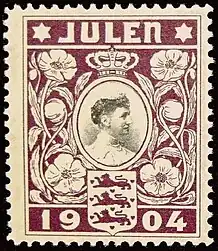Issued in Denmark, 1904, features the Danish Queen Louise[lower-alpha 1]
Christmas seals are adhesive labels that are similar in appearance to postage stamps that are affixed to mail during the Christmas season to raise funds and awareness for charitable programs. Such seals have become particularly associated with lung diseases such as tuberculosis, and with child welfare. Christmas seals were first issued in Denmark beginning in 1904 and in little time were and continue to be issued by various other countries. Christmas Seals sometimes were sometimes mistaken for Christmas stamps used for postage, prompting the US Post Office to adopt a policy requiring seals to be affixed on the reverse side of mail, but it only proved to be e temporary policy. Christmas seals exist in several varieties, most notably those first issued by the Red Cross and later by the National Tuberculosis Association[lower-alpha 2] with its red double barred cross on the face of the seal. From the onset Christmas seals were sought after by collectors and today their monetary worth varies considerably.
Danish origin
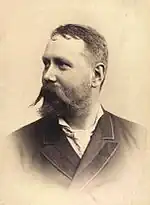
At the beginning of the 1900s tuberculosis was a greatly feared disease, and its harmful effects on children seemed particularly devastating. In 1904, Einar Holbøll, a Danish postal clerk, developed the idea of adding an extra charitable stamp on mailed holiday greetings during Christmas.[1] The money raised could be used to help children sick with tuberculosis.[2] The plan was approved by the Postmaster and the King of Denmark (Christian IX).[3][4]
In 1904, the world's first Christmas seal was issued, bearing the likeness of the Danish Queen (Louise of Hesse-Kassel) and the word Julen (Christmas). Over 4 million were sold in the first year at DKK 0.02 per seal, raising more than $18,000, which in 1904 was a considerable sum of money. The following year the sale of Christmas Seals brought even more money to the fight against tuberculosis.[5][6]
During the first six years, enough funds were raised to build the Christmas Seal Sanatorium in Kolding, which was opened in 1911. The same year the sanatorium was transferred to the administration of the Danish National Association to Combat Tuberculosis as it was considered a waste of resources to have two organizations working towards the same purpose. Fundraising would successfully continue via Christmas Seals for years to come.[7]
The Danish Christmas Seal Committee – today known as Julemærkefonden (the Christmas Seal Fund) - decided at that time to put all future collected funds to use in building and operating convalescent homes for children.[8]
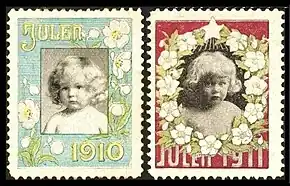 Christmas seals, Denmark, 1910 & 1911 |
 Selection of Danish Christmas seals, 1916, 1922, 1951 issues |
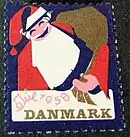
In 1958 a controversy over the appearance of Santa Claus on a Danish Christmas seal started when Rev. Paul Nedergad, a Copenhagen clergyman, referred to Santa Claus as a "pagan goblin". He insisted that people should find another way to help the charitable cause to fight tuberculosis and boycott the Christmas seal in question. Most of the people of Denmark, however, paid little attention to Negerdard's comment and continued to buy the Christmas seals that depicted Santa Claus.[9]
In the United States

At the beginning of the 20th century the United States was also experiencing a tuberculosis outbreak of epidemic proportions. At the time the only practical way to treat the disease was confining those afflicted in a sanatorium. Most of these facilities, however, were in dire need of funding and were faced with closure. One such facility was located in Brandywine, Delaware, and almost at the point of its termination, where a doctor, Joseph Wales, remembered his cousin Emily Bissell who was experienced in fundraising efforts. He subsequently sent her a letter relating the situation his sanatorium was facing. Bissell was touched by his letter and sent out looking for ways to raise the $300 needed for her cousin's sanatorium to remain open.[11]
The Great success of Christmas seals in Europe prompted Danish born Jacob Riis, a muckraking journalist, photographer and a friend of Theodore Roosevelt, to write an editorial advocating their sale in America. The editorial and the great success Christmas Seals brought to charitable efforts in Europe in 1904 was a great source of inspiration to [Emily Bissell]] who pursued the prospect in the United States and organized the production and sale of Christmas Seals in America.[2][12] Bissell likewise hoped to raise money for her cousin's a sanatorium on the Brandywine Creek in Delaware. Bissell went on to design a Delaware local Christmas seal, the first to be issued in the United States in 1907. By 1907 Christmas Seals were introduced to the United States by Emily Bissell, Christmas seals generated $3000 in the first year. By 1909 sales generated $250,000. It became clear to the Red Cross sales of Christmas seals should continue as an independent enterprise. The Director of the American Red Cross, Ernest P. Bicknell, was a member of the Board of Directors of the National Tuberculosis Association, now in its sixth-year of operation. Bicknell along with Dr. Livingston Farrand, a member of the faculty of Columbia University proceeded in the summer of 1910 to arrange a partnership in the sale of Christmas Seals with the Red Cross, which lasted until 1920, when the Red Cross turned over the entire Christmas seal operation to the National Tuberculosis Association. In the succeeding years sales grew continuously, from three thousand dollars in 1907 to 26 million dollars by 1955.[13][14]
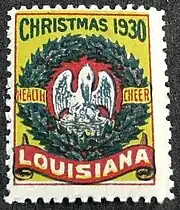
Initially printed by the Lithograph process, the seals were sold in post office lobbies across the United States.[2] The first U.S. Christmas seal of 1907 was initially sold on December 7, 1907 in Wilmington, Delaware by the Delaware Chapter of the American Red Cross, at a penny each. By 1908, Bissell's idea grew to a national program administered by the National Association for the Study and Prevention of Tuberculosis (NASPT) Christmas seals issued from 1908 to 1918 were issued nationally by the American National Red Cross. Net proceeds from the sales would be divided equally between the two organizations. [15][16] Beginning in 1919 when the National Tuberculosis Association assumed operations of Christmas seal production all seals bore the red double-barred cross in the designs.[17] By 1920, the Red Cross withdrew from the arrangement and sales were conducted exclusively by the NASPT, then known as the National Tuberculosis Association (NTA). Issues from 1920 to 1937; by the National Tuberculosis and Respiratory Disease Association (NTDRA); from 1968 to 1972 and the American Lung Association from 1973 to the present The NTRDA became the American Lung Association in 1973, though the 1974 seals and those issued thereafter continue to show the NTRDA inscription on the sheet margin.[18][17]

Local Christmas seals also began to emerge during this time and have existed alongside national issues in the US since 1907, and are also catalogued by the Christmas Seal & Charity Stamp Society.[11][19]
Various promotional schemes were tried: in 1954 the small town of Saranac Lake, New York (home of the Adirondack Cottage Sanitarium) won a nationwide competition selling Christmas seals, the reward for which was hosting the world premiere of the Paul Newman film The Silver Chalice; the cast participated in a parade in the town's annual winter carnival.
Beginning in 1935 Christmas seals were being printed in se-tenant, where there was more than one design of Christmas seals on a single sheet of one hundred Christmas seals.[20]
 :US Christmas seals in se-tenant form |
The Christmas song, Mistletoe and Holly written by Frank Sinatra in 1957 was selected as the theme song for the 1960 Christmas Seals appeal.[21]
Today the Christmas seals benefit the American Lung Association and other lung related issues. Tuberculosis was declining, but recently has been on the rise. Tuberculosis is still one of the most common major infectious diseases in the world. In 1987 the American Lung Association acquired a trademark for the term "Christmas Seals" to protect their right to be the sole US national fundraising Association to issue them. Of course, this trademark would not apply to Christmas seals issued outside the US or local and regional Christmas seals, used in the US by many organizations since 1907 when the Kensington Dispensary in Philadelphia, Pennsylvania, issued their own local Christmas seal.[18]
In Canada

By 1908, the campaign had reached Canada. Interested people in Toronto and Hamilton, Ontario began Christmas seal campaigns to build and support sanatoria, as tuberculosis hospitals were then called.
The Toronto Globe came promptly to their aid. Early in December, the Globe began running a daily story on the front page giving news of the campaign. The column was bordered by holly so that readers could easily spot it.
One story told how the children of 58 Toronto schools had sold 10,000 Christmas seals. Another issue announced that out in Regina, Saskatchewan another paper, the Regina Leader, had written to say its staff would sell the seals and send the money back for the sanatorium being built in Muskoka.
From Saint John, New Brunswick, the Rev. G. A. Moore wrote to say that he and other volunteers would sell 8,500 and send the money to Toronto for the sanatorium.
That first year, the Toronto campaign brought in $6,114.25 and Hamilton citizens gave $1,244.40. Year by year, other cities across Canada tried the Christmas seal campaign as a means not only of raising money but of creating the awareness that tuberculosis could be controlled.
Finally, in 1927, it was agreed that the Christmas seal campaign was to be the official method for tuberculosis associations to appeal to the public for funds. A national seal was established.
Christmas seal campaigns have played an important role in public health. At first, the money raised was used for the new and badly needed sanatoria. When these were established, Christmas seal funds were used for tuberculosis prevention. The seals have paid for millions of Canadians to have chest X-ray or tuberculin tests. As a result, thousands of tuberculosis cases were discovered before disease spread to others.
The Canadian Lung Association's Christmas seals continue to symbolize the grassroots support of Canadians that helped win the fight against tuberculosis.[23]
In Europe
Soon after Denmark issued the first Christmas seal, Sweden and Iceland followed Seals then spread throughout Scandinavia and every major country in Europe, and are still popular today. Christmas seals have been issued by hundreds of different societies, nationally, and locally in Asia, Africa, North and South America, and Australia. The majority of all tuberculosis seals since then were issued at Christmas time and included the international symbol against tuberculosis, the double barred Cross of Lorraine.[2][12]
 Selection of European Christmas Seals |
Other countries
There are nearly one hundred different lung associations worldwide that issue Christmas seals. Many different countries issue their own Christmas seals, as well as cities, states and territories. Green's Catalog, considered by many collectors as the bible of US and worldwide tuberculosis Christmas seal collecting would distinguish them as national versus local Christmas seals. Many tuberculosis seal issuing societies are members of the International Union against Tuberculosis and Lung Disease, which holds a Christmas seal contest for best design among their Organizational and Constituent seal issuing members at their annual World Conference on Lung Health.[24]
 From left to right: Argentina, 1938, Chili, 1940s, Korea 1937-1938, Mexico, 1955, South Africa, 1938 |
Usage
Beginning in 1907 when Christmas seals were first issued the incident of seals used in place of postage stamps became a common problem. Subsequently, by 1911 the U.S. Post Office adopted a policy that prohibited the placement of Christmas Seals on the same side of a postcard or envelope as the address. By 1930 the problem became less prevalent.[25]
Before 1930 nearly all Christmas Seals found on U.S. mail were used on Christmas greetings postcards, as there were no commercial Christmas Cards with envelopes. Today postcards with Christmas seals are not common and often scarce, and in some instances rare.[26]
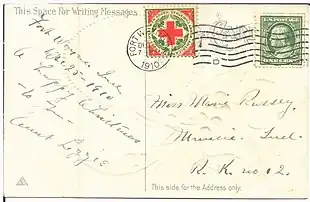 Postcard with United States postage and Christmas Seal, postmarked December 21, 1910 |
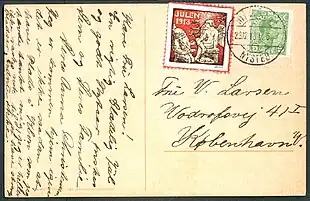 Postcard with Danish postage and Christmas seal, postmarked December 23, 1913 |
Unofficial seals
Many other charitable funds were issued at Christmas time, often with Christmas themes, by religious organizations, civic and fraternal societies, patriotic organizations, sororities, etc., but since they were not issued to fight tuberculosis, they lack the double barred cross of Lorraine, the international symbol for the fight against tuberculosis, proposed in 1902 at the International Conference on Tuberculosis in Berlin Germany, and strictly speaking do not qualify as Christmas seals.
 Salvatorian Seminary Catholic charity seals of 1920 |
Between 1937 and 1943 the Danish Nazi Party (DNSAP) issued a variety of seals featuring the Nazi swastika.[27] These scarce seals contain Christmas themes like holly, but no known connection to the fight against tuberculosis, and for this reason, they are not listed in Green's Catalog.
History has shown that most dictatorial regimes suspend Christmas seals from being issued. This happened in Korea under the Japanese occupation, China under the communists, and Argentina under Eva Peron.
Collecting

When Christmas seals first appeared at the beginning of the 20th century they received much favor and acclaim from the general public, and from stamp and postal history collectors in particular. Prices for the various issues can range from inexpensive, to moderately priced to those of considerable value, depending on availability, type,[lower-alpha 4] centering and condition.[28] The catalogue value of a Christmas seal, as with postage stamps, usually increases over time. For example, in 1935 the Scott Catalogue [lower-alpha 5] value for a Christmas seal issued in 1915 was 25-cents.[29] In 1983 its catalogue value increased to $4.50.[30] By 2014 the Scott Catalogue Value was fixed at $9.00.[31] In cases where a Christmas seal is tied[lower-alpha 6] along side a postage stamp, with a postmark with the same year date in which the given Christmas seal was issued often commands much higher prices than those that have been cancelled and are no longer affixed to a postcard or envelope.[28] As with various postage stamps, Christmas seals that exist in a 'block of four' are often scarce and can increase the value much higher than what four separate Christmas seals might be worth.[33] On December 4, 2014, a postcard bearing a rare variety of a 1911, type 5, considered the rarest U.S. Christmas seal, sold at auction on eBay for a record amount of $$3,433.83. The postcard was postmarked December 20, 1911, at Station C in Los Angeles and mailed to Fort Wayne, Indiana[34] In another definitive example, a 1919 issue U.S. Christmas seal of a rare type was sold at auction and realized a price of $3,872,533.[35]
See also
- MV Christmas Seal
- The Christmas Seal & Charity Stamp Society
- Easter Seals A charitable organization for helping handicapped children.
- Easter seals (philately) Easter seals in stamp collecting.
Notes
- ↑ "Julen" is Danish for 'Christmas'.
- ↑ Now known as the American Lung Association
- ↑ This Canadian Christmas seal, along with several other types, are identical to those issued for the United States, except for the name of country on the seal.[22]
- ↑ Stamps and seals of a different "type" are most often those with minor, often unnoticeable, differences in the design or color(s) used in the printing process..
- ↑ The Scott Catalogue is considered one of the leading authorities on postage stamps and related items.
- ↑ "Tied" is a term used by collectors to define a stamp with a postmark on an envelope which overlaps the stamp.[32]
Citations
- ↑ Loytved, G. (2006). "[Christmas seals]". Pneumologie (Stuttgart, Germany). 60 (11): 701–710. doi:10.1055/s-2006-944325. ISSN 0934-8387. PMID 17109268.
- 1 2 3 4 Healey, Barth (24 December 1989). "Pastimes: Stamps". Archives, The New York Times.
- ↑ krythe1954, pp. 138-139
- ↑ Tower, Samuel A. (1979-11-25). "STAMPS". The New York Times. ISSN 0362-4331. Retrieved 2021-05-20.
- ↑ American red Cross
- ↑ Collins & Ace, 2003, p. 63
- ↑ Collins, 2003, pp. 51-53
- ↑ "Flere testamenterer til et godt formål". www.julemaerket.dk (in Danish). Retrieved 2021-05-20.
- ↑ Clar, Journal article, October 1959 p. 337
- ↑ Denune, 2014, p. 1
- 1 2 The Lancet, journal, 2014, v. 2, pp. 608-609
- 1 2 Del Re, 1979, pp. 141-142
- ↑ History Matters, Essay
- ↑ Long, 1957, p. 144
- ↑ |Scott's specialized catalogue of U.S. stamps, 1935, p. 163
- ↑ Denune, 2014, p. 1
- 1 2 Denune, 2014, pp. a, 4-5
- 1 2 Scott's Specialized Catalogue of [US], 1983, p. 613
- ↑ Scott's specialized catalogue of U.S. stamps, 1969, p. 569
- ↑ Denune, 2014, pp. 14-19
- ↑ Gigliotti, 2002, p. xviii
- ↑ Scott Specialized Catalogue of US stamps, p. 619
- ↑ Association, Lung. "History: Support Christmas Seals". Canadian Lung Association. Archived from the original on 15 November 2011. Retrieved 13 October 2011.
- ↑ International Union Against Tuberculosis and Lung Disease, 2020
- ↑ Hotchner, 2016: Linn's Stamp News, Nov 16, 2016 issue
- ↑ Denune, 2023, comprehensive catalogue
- ↑ "Jay Smith & Associates: Denmark: Christmas Seals: Christmas Seals - Danish Nazi Party". www.jaysmith.com. Retrieved 2021-05-20.
- 1 2 Denune, 2014, pp. a-b
- ↑ Scott Specialized Catalogue of US Stamps, 1935, p. 164
- ↑ ref=scott1983|Scott Specialized Catalogue of US Stamps, 1983, p. 614
- ↑ Denune, 2014, p. 3
- ↑ Denune, 2014, p. b
- ↑ Denune, 2014, pp. 3, 8, 14, etc
- ↑ Linn's Stamp News, December 4, 2014
- ↑ Denune, 2014, p. 4
Bibliography
- Del Re, Gerard (1979). The Christmas almanack. Garden City, N.Y.: Doubleday. ISBN 038-513353-7.
- Denune, John, Jr., ed. (2014). The Christmas Seal Catalog (PDF). The Christmas Seal and Charity Stamp Society.
The Christmas Seal Catalog is a simplified version of Green's Catalog of TB Seals of the World, part 1, U.S. National Christmas Seals.
{{cite book}}: CS1 maint: multiple names: editors list (link) - Clar, Mimi (October 1959). "Attack on Santa Claus". Western Folklore. 18 (4): 337. JSTOR 1497769.
- Collins, Ace (2003). Stories behind the great traditions of Christmas. Grand Rapids, Mich.: Zondervan. ISBN 978-0-31024-8804.
- Denune, John. "US Christmas Seals Tied On". John Denune's ChristmasSeals.net. Retrieved December 14, 2023.
- Hotchner, John M. (2016). "When Christmas seals were placed on mail where they shouldn't be". Linn's Stamp News. Retrieved December 14, 2023.
- Gigliotti, Gilbert L. (2002). A Storied Singer: Frank Sinatra as Literary Conceit. Bloomsbury Academic. ISBN 978-0-31330-9731.
- Krythe, Maymie Richardson (1954). All about Christmas. New York: Harper & Brothers.
- Long, Esmond R. (April 1957). "Development of the Voluntary Health Movement in America as Illustrated in the Pioneer National Tuberculosis Association". Proceedings of the American Philosophical Society. American Philatelic Society. 101 (2): 142–148. JSTOR 985505.
- Scott Specialized Catalogue of United States stamps. New York, N.Y: Scott Publications. 1969.
- Scott Specialized 1935 Christmas Seal Section (PDF). New York: Scott publishing Company. 1935.
- Scott Specialized Catalogue of United States stamps. New York, NY: Scott Publishing Company. 1983.
- "The American Red Cross and the First Christmas Seals". The American Red Cross. Retrieved December 15, 2023.
- This Day in History... December 7, 1907, First U.S. Christmas Seals (PDF). Camden, New York: Mystic Stamp Company. 2023.
- Media, Delaware Public (15 December 2011). "History Matters: Christmas Seals - The Legacy of Emily Bissell". www.delawarepublic.org. Retrieved 2021-05-20.
- Venkatesan, Priya (August 2014). "Historical Profile, Emily Perkins Bissell" (PDF). The Lancet. 2.
- "Tied U.S. Christmas seal variety brings record price in recent auction on eBay". Linn's Stamp News. Sydney, Ohio. December 4, 2014. Retrieved January 6, 2024.
- "The Union Christmas seals exhibition and contest calls for designs". International Union Against Tuberculosis and Lung Diease. 24 August 2020. Retrieved January 17, 2024.
External links
- The Christmas Seal and Charity Stamp Society A non profit organization founded in 1931, publishing catalogs of worldwide fund raising seals including Christmas and Easter seals, as well as a quarterly journal, Seal News.
- The Cinderella Stamp Club Archived 2019-07-18 at the Wayback Machine
- Danish Christmas seals from 1904 onwards
- Annual Christmas Seal Contest at World Conference on Lung Health, the convention of the International Union against TB & Lung Disease
